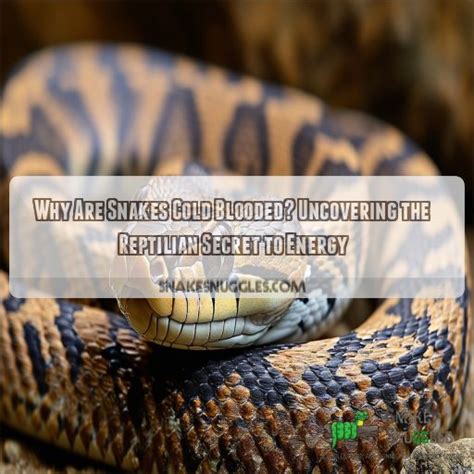Are Snakes Cold Blooded

Snakes, like all reptiles, are ectothermic, meaning they rely on external sources of heat to regulate their body temperature. This characteristic is often referred to as being "cold-blooded," although this term is somewhat misleading. The notion of being cold-blooded does not imply that snakes or other reptiles are always cold; rather, it signifies that they do not generate heat internally, unlike mammals and birds, which are endothermic and maintain a relatively constant body temperature regardless of their environment.
The classification of snakes as ectothermic has significant implications for their behavior, physiology, and ecology. For instance, snakes often bask in the sun or seek out warm surfaces to absorb heat, which is essential for their metabolic processes, including digestion and muscle function. This dependence on external heat sources means that snakes are most active in warmer environments and during the warmer parts of the day, although specific behaviors can vary widely among different species.
Key Points
- Snakes are ectothermic, relying on external heat sources to regulate their body temperature.
- The term "cold-blooded" is often used to describe this condition but can be misleading as it does not imply a constant cold body temperature.
- Snakes' ectothermic nature affects their activity patterns, with most species being more active in warmer conditions.
- Different species of snakes exhibit varied adaptations to their thermal environments, including behavioral and physiological responses.
- Understanding the thermal ecology of snakes is crucial for managing their populations and conserving their habitats.
Thermal Ecology of Snakes

The thermal ecology of snakes is a complex field of study that encompasses how these animals interact with their thermal environment. Snakes have evolved a range of strategies to cope with temperature fluctuations, including behavioral adaptations such as basking, seeking shade, and burrowing. Some species are also capable of physiological adjustments, such as changing their metabolic rates or producing antifreeze proteins to survive in colder conditions.
Behavioral Adaptations
Behavioral adaptations are crucial for snakes to maintain optimal body temperatures. Basking, for example, allows snakes to rapidly increase their body temperature, which is essential for hunting, digesting food, and reproducing. Conversely, seeking shade or burrowing into cooler substrates helps snakes avoid overheating during the hottest parts of the day. These behaviors are finely tuned to the thermal conditions of their environments, highlighting the intimate relationship between snakes and their thermal niches.
| Species | Preferred Temperature Range (°C) | Behavioral Adaptation |
|---|---|---|
| Cobra | 25-35 | Basking and seeking shade |
| Rattlesnake | 20-30 | Burrowing and thermoregulation |
| Python | 22-32 | Thermoregulation through basking and coiling |

Physiological Adaptations

Beyond behavioral adaptations, snakes also exhibit physiological adaptations that enable them to survive and thrive in a variety of thermal environments. For example, some species can alter their metabolic rates in response to temperature changes, a strategy that helps conserve energy in colder conditions. Additionally, the ability to regulate their body temperature through physiological means, such as producing heat-shock proteins, is crucial for snakes living in temperate or cold climates.
Evolutionary Perspectives
From an evolutionary standpoint, the ectothermic nature of snakes has presented both challenges and opportunities. The need to regulate body temperature through external means has driven the evolution of complex behaviors and physiological traits. However, this dependence on environmental temperature also makes snakes vulnerable to changes in their thermal niches, such as those induced by climate change. Understanding the evolutionary history of snakes’ thermal ecology can provide insights into how these animals might adapt to future environmental challenges.
What does it mean for snakes to be ectothermic?
+Being ectothermic means that snakes rely on external sources of heat, such as the sun or a warm rock, to regulate their body temperature, as opposed to generating heat internally like mammals and birds.
How do snakes adapt to cold temperatures?
+Snakes adapt to cold temperatures through behavioral adaptations like seeking shelter, burrowing, or migrating to warmer areas, and physiological adaptations such as reducing metabolic activity or producing antifreeze proteins.
Can snakes survive in extremely cold environments?
+Some species of snakes can survive in extremely cold environments through specific adaptations, but most snakes are found in temperate or tropical regions where temperatures are more favorable for their ectothermic metabolism.
In conclusion, the question of whether snakes are cold-blooded is more nuanced than a simple yes or no answer. Snakes’ ectothermic nature significantly influences their behavior, physiology, and ecology, making them fascinating subjects for study in the fields of herpetology and thermal ecology. As we continue to learn more about these animals and their intricate relationships with their thermal environments, we are reminded of the complexity and beauty of life on Earth, and the importance of preserving biodiversity in the face of global change.